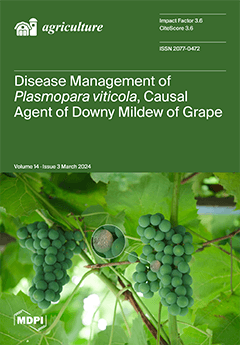Drone multispectral technology enables the real-time monitoring and analysis of soil moisture across vast agricultural lands. overcoming the time-consuming, labor-intensive, and spatial discontinuity constraints of traditional methods. This study establishes a rapid inversion model for deep soil moisture (0–200 cm) in dryland agriculture
[...] Read more.
Drone multispectral technology enables the real-time monitoring and analysis of soil moisture across vast agricultural lands. overcoming the time-consuming, labor-intensive, and spatial discontinuity constraints of traditional methods. This study establishes a rapid inversion model for deep soil moisture (0–200 cm) in dryland agriculture using data from drone-based multispectral remote sensing. Maize, millet, sorghum, and potatoes were selected for this study, with multispectral data, canopy leaf, and soil moisture content at various depths collected every 3 to 6 days. Vegetation indices highly correlated with crop canopy leaf moisture content (
p < 0.01) and were identified using Pearson correlation analysis, leading to the development of linear and nonlinear regression models for predicting moisture content in canopy leaves and soil. The results show a significant linear correlation between the predicted and actual canopy leaf moisture levels for the four crops, according to the chosen vegetation indices. The use of canopy leaf moisture content to predict surface soil moisture (0–20 cm) demonstrated enhanced accuracy. The models designed for the top 20 cm of soil moisture successfully estimated deep soil moisture levels (up to 200 cm) for all four crops. The 20 cm range soil moisture model showed improvements over the 10 cm range model, with increases in Root Mean Square Error (RMSE), Mean Absolute Error (MAE), Coefficient of Determination (R
2), and Nash–Sutcliffe Efficiency Coefficient (NSE) by 0.4, 0.8, 0.73, and 0.34, respectively, in the corn area; 0.28, 0.69, 0.48, and 0.25 in the millet area; 0.4, 0.48, 0.22, and 0.52 in the sorghum area; and 1.14, 0.81, 0.73, and 0.56 in the potato area, all with an average Relative Error (RE) of less than 10% across the crops. Using drone-based multispectral technology, this study forecasts leaf water content via vegetation index analysis, facilitating swift and effective soil moisture inversion. This research introduces a novel method for monitoring and managing agricultural water resources, providing a scientific basis for precision farming and moisture variation monitoring in dryland areas.
Full article





